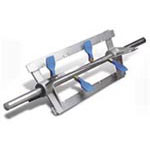Anti-blinding Devices



Kason offers a variety of anti-blinding devices that increase production by dislodging near-size particles from apertures of the screen. These devices reduce the clearance between the rotating paddle and the cylindrical screen without contacting or abrading the screen. Narrowing the gap between the rotating element and the screen surface enhances screening rates under near size conditions, thereby increasing throughput.
At top, rubber wiper blades handle fibrous material that would otherwise become entangled in brush bristles or wrap around serrated edges. Rubber blades allow oversize particles to pass by the rotating blade, and are also effective in liquid/solids separations.
At center, integral air brushes keep screens clean when processing with fine meshes that would be susceptible to damage or abrasion by mechanical anti-blinding devices. Air enters at the end of the hollow drive shaft and exits through multiple air nozzles, blowing the screen clean.
At bottom, brushes are flexible, and maintained approximately 1/16" to 1/8" (1.6mm to 3.2mm) away from the screen surface to prevent damage, while allowing desired particles to pass easily through the screen openings.
Belt Drive and Direct Drive Configurations


All Kason Centrifugal Sifter models are available in belt drive(top) and direct drive(bottom) configurations.
Clean-In-Place (CIP) Design, Construction and Finish

Vibroscreen® vibratory screeners designed, constructed and finished to Clean-In-Place (CIP) specifications employ spray nozzles that are strategically placed to emit cleaning solutions, rinsing solutions and/or steam for sanitizing the interior of the screening chamber(s) without the need to open or otherwise disassemble the unit.
The perforated, ball-shaped, stainless steel nozzles are positioned at the end of stainless steel pipes that extend outward from the screen deck frames and upward from the top surfaces. Their flanged connections ensure leak-free connection to hoses carrying cleaning solution.
Quick-disconnect clamps allow two-minute disassembly of all water supply hoses, clean-in-place spray head fittings, and screener body sections for inspection or screen changes. Unlike traditional circular vibratory screeners, CIP screener frames and screens are designed to eliminate the gap that normally exists between the mounted screen and the frame wall.
CIP screeners are offered in diameters from 18 to 60" (460 to 1525mm) in all-stainless construction finished to FDA as well as 3-A, BISSC and other sanitary standards.
Design, Construction and Finish to Pharmaceutical Specifications

Vibroscreen® vibratory screeners for pharmaceutical applications feature clean-in-place spray heads for hands-free wash down. The pharmaceutical screener shown is configured with one gap-free screening deck. Three clean-in-place spray heads are required: one each for the upper, central and lower chambers.
Quick-disconnect clamps allow two-minute disassembly of all water supply hoses, clean-in-place spray head fittings, and separator body sections for inspection or screen changes. Unlike traditional circular screen separators, this sifter has no gaps between the mounted screen and the frame wall.
It is offered in diameters from 18 to 60" (460 to 1525mm) in all-stainless construction finished to FDA as well as 3-A, BISSC and other sanitary standards.
Design, Construction and Finish to FDA, 3-A, BISSC, EEC and Other Sanitary Standards

All Kason centrifugal sifters are available designed, constructed and finished to industrial, food, dairy, and pharmaceutical standards including FDA, 3-A, BISSC, EEC and others. Sanitary screeners generally offer one or more of the following features:
- Clean-In-Place (CIP) spray nozzles
- Radius corners and ground/polished welds
- Quick-release fittings
- Three-bearing cantilevered shaft for quick removal of internals
- Thread-free internals and tool-free disassembly for fast, thorough washdown (shown)
Twin Centrifugal Sifter Configuration

Kason twin centrifugal sifter configurations are designed for applications requiring greater capacity than a single high-capacity unit can provide. These duplex units are equipped with a splitter to evenly divide the flow of incoming material, regardless of feed rate.










